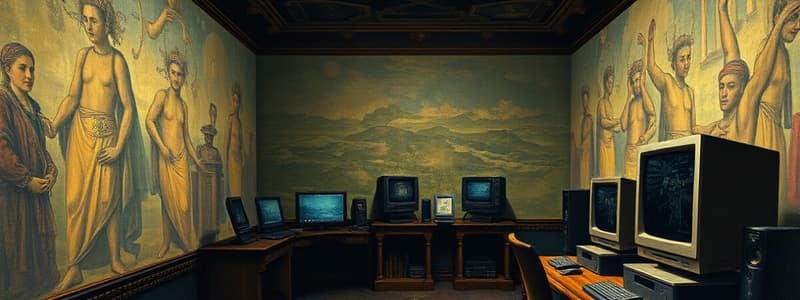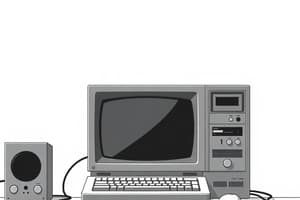Podcast
Questions and Answers
What mediums can represent a number or quantity as described in the evolution of computers?
What mediums can represent a number or quantity as described in the evolution of computers?
Pebbles, vacuum tubes, marks on paper, transistors, and integrated circuits.
How did Charles Babbage contribute to the development of modern computing?
How did Charles Babbage contribute to the development of modern computing?
He proposed the analytical engine, which included features like input, storage, and processing that characterize modern computers.
What was Ada Lovelace's significance in the field of computer science?
What was Ada Lovelace's significance in the field of computer science?
She is known as the world's first computer programmer for developing instructions for the analytical engine.
What was the impact of Herman Hollerith's tabulating machine on the 1890 U.S. census?
What was the impact of Herman Hollerith's tabulating machine on the 1890 U.S. census?
Describe the vulnerability of Babbage's analytical engine.
Describe the vulnerability of Babbage's analytical engine.
What evolution in technology did transistors facilitate in computing?
What evolution in technology did transistors facilitate in computing?
What marked the shift from mechanical to electronic power in early computing?
What marked the shift from mechanical to electronic power in early computing?
Which computer is recognized as the first general-purpose computer?
Which computer is recognized as the first general-purpose computer?
What was a major disadvantage of the first generation of computers that used vacuum tubes?
What was a major disadvantage of the first generation of computers that used vacuum tubes?
How did the introduction of transistors transform computing during the second generation?
How did the introduction of transistors transform computing during the second generation?
What technological advancement characterized the third generation of computers?
What technological advancement characterized the third generation of computers?
What was the significance of Intel’s 4004 microprocessor?
What was the significance of Intel’s 4004 microprocessor?
How did the invention of personal computers in the 1980s impact society?
How did the invention of personal computers in the 1980s impact society?
What role did artificial intelligence play in the fifth generation of computers?
What role did artificial intelligence play in the fifth generation of computers?
Which company introduced the first home computer with a graphical user interface in 1983?
Which company introduced the first home computer with a graphical user interface in 1983?
What was the main purpose of the Universal Automatic Computer (UNIVAC 1) delivered in 1951?
What was the main purpose of the Universal Automatic Computer (UNIVAC 1) delivered in 1951?
What were the early methods of representing numbers before the invention of computers?
What were the early methods of representing numbers before the invention of computers?
Who is considered one of the pioneers in computing and what was their contribution?
Who is considered one of the pioneers in computing and what was their contribution?
How did transistor technology revolutionize computer development?
How did transistor technology revolutionize computer development?
Name one of the first digital computers and a key feature of it.
Name one of the first digital computers and a key feature of it.
What impact have computers had on everyday life?
What impact have computers had on everyday life?
In what ways have computers changed the field of information management?
In what ways have computers changed the field of information management?
What was the role of the microprocessor in the development of modern computers?
What was the role of the microprocessor in the development of modern computers?
Explain how the concept of 'office packages' is related to computer usage in society.
Explain how the concept of 'office packages' is related to computer usage in society.
Flashcards are hidden until you start studying
Study Notes
Evolution of Computers
- The shift to electrical power in computing began in 1924, moving away from mechanical power.
Early Computers
- Late 1942: Atanasoff-Berry Computer (ABC) developed, recognized as the first electronic digital computer.
- 1944: IBM's Mark I, created by Howard Aiken, was unveiled.
- 1946: ENIAC, based on the ABC, was introduced as the first general-purpose computer.
First Generation (1951-1958): The Vacuum Tube
- 1951: UNIVAC 1 delivered to the US Bureau of the Census, marking its relevance for business applications.
- Utilized thousands of vacuum tubes, which posed challenges like heat issues and frequent failures.
- 1957: Magnetic tape storage was adopted for data management.
Second Generation (1959-1964): The Transistor
- Bell Labs developed the transistor, enhancing electronic devices' efficiency and size.
- Transistors were smaller, required no warm-up time, and consumed less power, increasing reliability.
- Transition from machine language to assembly language and high-level languages began.
- Computers primarily used by businesses, universities, and government entities.
Third Generation (1965-1970): The Integrated Circuit
- Integrated Circuits (ICs) allowed multiple electronic components to be placed on a single silicon chip.
- ICs started to replace transistors in 1965, contributing to significant size and efficiency improvements.
- More advanced software solutions emerged, allowing access to computers via terminals.
Fourth Generation (1971-Today): The Microprocessor
- Introduction of Intel's 4004 microprocessor, marked by general-purpose processing on a chip.
- Enabled the development of various digital devices like calculators and watches.
Fifth Generation (Today-Future): Artificial Intelligence
- AI research initiated by Japan’s MITI in the 1970s, focusing on high-level computations using parallel processing.
- 1981: Launch of IBM PC, the first mainstream personal computer.
- 1983: Apple Lisa was introduced as the first home computer to feature a graphical user interface (GUI).
- 1984: Apple Macintosh followed, further popularizing PCs.
Basic Components of a Computer System
- A computer accepts input data, processes it to create useful information, stores instructions and results, and produces final output.
Role of Information Technology
- IT supports managing information through modern technology for capturing, storing, retrieving, analyzing, and communicating data.
- IT spans various fields including education, finance, travel, government, manufacturing, health, and publishing.
Historical Context of Computing
- Early counting methods utilized physical objects (e.g., pebbles, marks).
- Charles Babbage proposed the analytical engine, incorporating features of modern computers such as input processing, storage, and output.
- Ada Lovelace, known as the first computer programmer, contributed to Babbage’s theoretical framework.
- Herman Hollerith invented a tabulating machine, revolutionizing the 1890 US census process, reducing counting time significantly, and later founded IBM Corp.
Studying That Suits You
Use AI to generate personalized quizzes and flashcards to suit your learning preferences.





